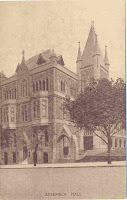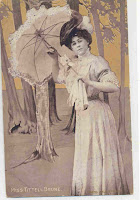I now have some titles available at the ibookstore, so if you are looking for some light reading.....
Houdini's Tour of Australia- A detailed account of Harry Houdini's tour of Australia in 1910.
Stars of Australian Theatre History
Australian theatre in the late 19th and early 20th centuries produced stars that shone nationally and internationally. Some of these stars were Maesmore Morris, dancers Saharet and Maggie Dickinson, pantomime dame, Arthur Stigant and American import Minnie Tittell Brune.

Stars of the Early Australian Stage- The Royal Comic Opera Company
The Royal Comic Opera Company was the most popular musical comedy company in Australia during the late 19th and early 20th centuries. The members of this company included George Lauri, Florence Young, Carrie Moore and Celia Ghiloni. Their stories are detailed here.
Pantomime in Australia-Pantomime in Australia reached its highest point during the Edwardian period. The people, the passion and the form combined to produce elaborate entertainment for early Australian audiences.
 Magical Tours of Australia-Magicians regularly toured Australia during the late 19th and early 20th centuries, this booklet discusses the tours of Chung Ling Soo, The Davenport Brothers and a Maskelyne Company of 1908
Magical Tours of Australia-Magicians regularly toured Australia during the late 19th and early 20th centuries, this booklet discusses the tours of Chung Ling Soo, The Davenport Brothers and a Maskelyne Company of 1908
.
 Magical Tours of Australia-Magicians regularly toured Australia during the late 19th and early 20th centuries, this booklet discusses the tours of Chung Ling Soo, The Davenport Brothers and a Maskelyne Company of 1908
Magical Tours of Australia-Magicians regularly toured Australia during the late 19th and early 20th centuries, this booklet discusses the tours of Chung Ling Soo, The Davenport Brothers and a Maskelyne Company of 1908.

A History of Some Australian Theatres-Australia was once home to some beautiful theatres. Her Majesty's in Sydney and the Tivoli in Melbourne being two of them. The performers and performances of a golden era are outlined here.
 Great Performances from Australian Theatre History-A selection of essays about great performances in Australian Theatre History. These include accounts of Blondin, Cinquevalli, The Oliviers and Nellie Melba's tours of Australia.
Great Performances from Australian Theatre History-A selection of essays about great performances in Australian Theatre History. These include accounts of Blondin, Cinquevalli, The Oliviers and Nellie Melba's tours of Australia.
 A history of Australian Theatre from Convict theatre to Depression.-A short history of Australian theatre covering the early convict years to the depression.
A history of Australian Theatre from Convict theatre to Depression.-A short history of Australian theatre covering the early convict years to the depression.
- Great Performances from Australian Theatre History-A selection of essays about great performances in Australian Theatre History. These include accounts of Blondin, Cinquevalli, The Oliviers and Nellie Melba's tours of Australia.
Great Performances from Australian Theatre History-A selection of essays about great performances in Australian Theatre History. These include accounts of Blondin, Cinquevalli, The Oliviers and Nellie Melba's tours of Australia. A history of Australian Theatre from Convict theatre to Depression.-A short history of Australian theatre covering the early convict years to the depression.
A history of Australian Theatre from Convict theatre to Depression.-A short history of Australian theatre covering the early convict years to the depression.You can look up the titles or just seach by my name- Leann Richards, free samples available.
-Leann
-Leann


















